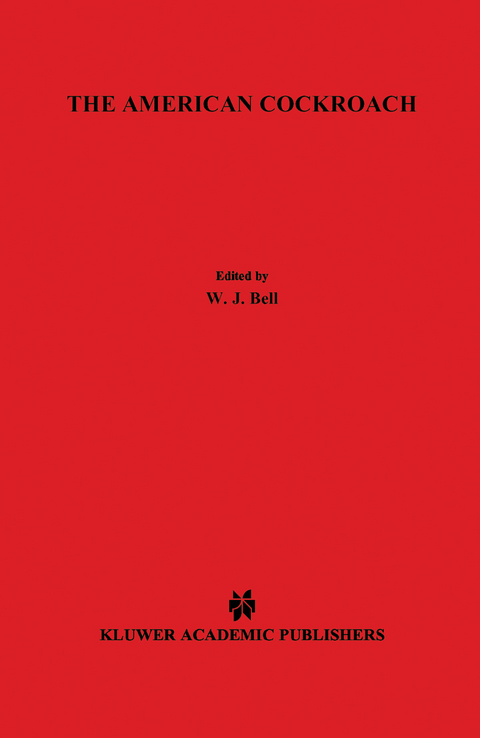
The American Cockroach
Chapman and Hall (Verlag)
978-0-412-16140-7 (ISBN)
1. Introduction.- 1.1 Distribution.- 1.2 Life cycle.- 1.3 Ecology.- 1.4 Biotic associations and medical importance.- 1.5 Economic and biological importance.- 2. Integument.- 2.1 Introduction.- 2.2 Structure of the integument.- 2.3 Integument during ecdysis.- 2.4 Stabilization of the oötheca.- 3. Circulatory System.- 3.1 Introduction.- 3.2 Heart and circulation.- 3.3 Haemolymph volume.- 3.4 Haemocytes.- 3.5 Constituents of haemolymph.- 4. Nutrition and Digestion.- 4.1 Introduction.- 4.2 Morphology of the alimentary canal and salivary glands.- 4.3 Nutrition.- 4.4 Enzymology.- 4.5 Physiology of digestion.- 4.6 Microbiology and pathology of the gut.- 5. Respiration.- 5.1 Introduction.- 5.2 Rates of gaseous exchange.- 5.3 Morphology of the tracheal system.- 5.4 Spiracle activity.- 5.5 Ventilation mechanisms.- 5.6 Diffusive-convective gas exchange in quiescent insects.- 6. Osmoregulation and Excretion.- 6.1 Introduction.- 6.2 Water relations.- 6.3 Components of water and ion metabolism.- 6.4 Excretory products.- 6.5 Regulation and kinetics of osmoregulation.- 6.6 Conclusions.- 7. Fat Body and Metabolism.- 7.1 Introduction.- 7.2 Morphology.- 7.3 Histology and ultrastructure.- 7.4 Bacteroids.- 7.5 Composition of fat body.- 7.6 Intermediary metabolism.- 7.7 Conclusions.- 8. Nervous System.- 8.1 Introduction.- 8.2 Structural organization of central and peripheral pathways.- 8.3 The extraneuronal compartment.- 8.4 Electrophysiology.- 8.5 Synaptic transmission.- 8.6 Toxicology.- 8.7 Functional organization.- 8.8 Learning.- 9. Sense Organs.- 9.1 Introduction.- 9.2 Visual system.- 9.3 Mechanoreceptive sensory systems.- 9.4 Antennal sensory system.- 9.5 Chemoreceptors on the maxillary palpus.- 9.6 Conclusions.- 10. Rhythms.- 10.1 Concepts and terminology.- 10.2 Circadian rhythms ofindividuals.- 10.3 Circadian rhythms of populations.- 10.4 Circadian rhythms of physiological systems.- 10.5 Location of photoreceptors and circadian pacemakers.- 10.6 Rhythms other than circadian.- 10.7 Conclusions.- 11. Muscles and Muscular Activity.- 11.1 Introduction.- 11.2 Organization and innervation.- 11.3 Biochemistry.- 11.4 Electrophysiology.- 11.5 Neuromuscular transmission and its chemical basis.- 11.6 Mechanical properties.- 11.7 Functional use of muscle.- 12. Neurosecretions and Hormones.- 12.1 Introduction.- 12.2 Neurosecretory cells (NSC).- 12.3 Corpora cardiaca (CC).- 12.4 Neurohormones of the ventral nerve cord.- 12.5 Corpora allata (CA).- 12.6 Prothoracic glands (PG).- 12.7 Ovary as an endocrine organ.- 13. Reproduction.- 13.1 Introduction.- 13.2 Female reproductive system.- 13.3 Male reproductive system.- 14. Pheromones and Behaviour.- 14.1 Introduction.- 14.2 Orientation.- 14.3 Courtship.- 14.4 Agonism.- 14.5 Aggregation.- 14.6 Learning.- 14.7 Conclusion.- 15. Embryonic and Post-Embryonic Development.- 15.1 Introduction.- 15.2 Embryogenesis.- 15.3 The ootheca.- 15.4 Culture of intact embryos ex-ovo.- 15.5 Embryonic behaviour development.- 15.6 Eclosion and hatching.- 15.7 Tissue culture of the embryonic nervous system.- 15.8 Conclusion.- 16. Regeneration.- 16.1 Introduction.- 16.2 Tissues with regenerative potential.- 16.3 Phenomenology of limb regeneration.- 16.4 Regulation of regeneration.- 16.5 Unified model.- 16.6 Conclusion.- References.- Species Index.
| Erscheint lt. Verlag | 31.12.1981 |
|---|---|
| Zusatzinfo | XVIII, 530 p. |
| Verlagsort | London |
| Sprache | englisch |
| Maße | 210 x 297 mm |
| Themenwelt | Naturwissenschaften ► Biologie ► Evolution |
| Naturwissenschaften ► Biologie ► Zoologie | |
| ISBN-10 | 0-412-16140-0 / 0412161400 |
| ISBN-13 | 978-0-412-16140-7 / 9780412161407 |
| Zustand | Neuware |
| Haben Sie eine Frage zum Produkt? |
aus dem Bereich


